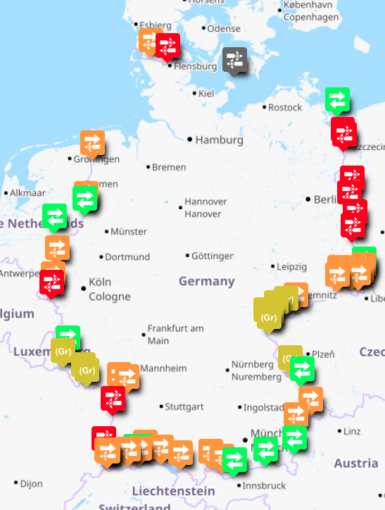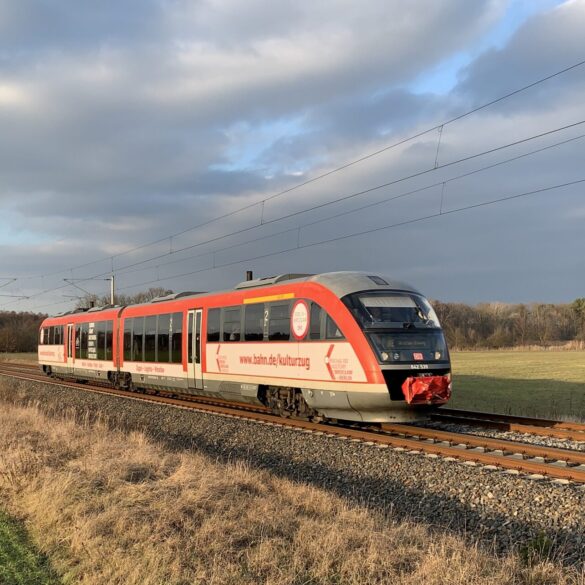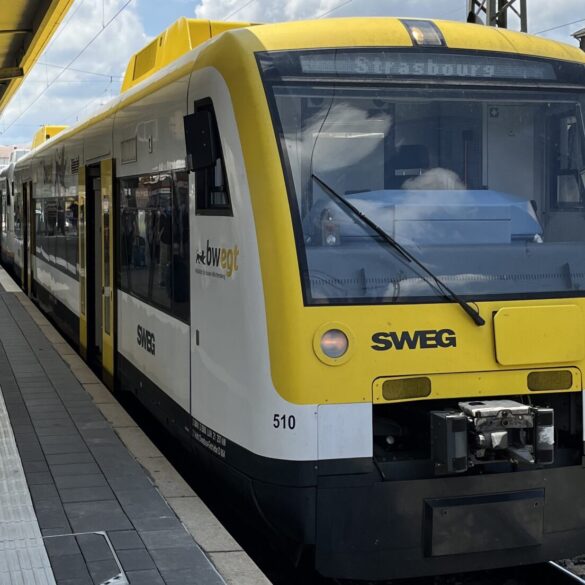At opposite ends of Germany there are two cross border railways where tickets for the trains are wonderfully simple – from Gronau (Nordrhein-Westfalen) to Enschede (Netherlands), and from Freilassing (Bayern) to Salzburg (Austria).
At two other borders – Kehl (Baden-Württemberg) to Strasbourg (France), and Forst Lausitz (Brandenburg) to Żary (Poland) – cross border ticketing does not work nearly as well as it should.
And all the other 54 cross border rail lines to/from Germany where there is passenger traffic are somewhere in between in terms of complexity for the passenger.

The reason for this is how border stations are defined in tariff systems, and how many stations, and on which sides of the border, these are located. The solution for the problem, as this blog post will explain in some detail, is to include at least one (and ideally more than one) actual, physical border station in the tariff systems of both countries.
First of all a step back.
The days of tickets simply being paid according to the kilometres a passenger travels are fading away in most European countries. It might still be possible to get such distance based tickets, but – especially for regional trains – for pretty much any journey you are going to pay less if you use what the Germans call the Verbundstarif – the regional tariff set (and subsidised) by the local public transport authority.
One of the reasons for the introduction of the 49 Euro Deutschlandticket was to eliminate the headaches at the borders between these public transport authorities within Germany. Were I to take a train from Berlin to Görlitz, I’d cross between Verkehrsverbund Berlin Brandenburg (VBB) and Zweckverband Verkehrsverbund Oberlausitz-Niederschlesien (ZVON) and end up with either an expensive trip, or need two separate tickets for each Verbund to keep the costs down. But there at least the station Spremberg is in both the VBB and the ZVON tariff schemes.
Now you see where I am going with this.
Imagine I am crossing an international border to or from Germany. On the German side I will have my Verbundstarif but on the other side I will have either a Verbundstarif from the neighbouring country, or a single ticket. But the question is whether what happens German side joins up neatly with what happens on the other side of the border.
The answer to that is it depends which border I am crossing. And this depends how many stations – none, one, or more than one – are included in national tariff systems at the border.
Some examples will help here.
At Gronau-Enschede the German tariff (including Deutschlandticket) is valid all the way to Enschede, and Dutch passes such as Traject Vrij are valid all the way to Gronau. Deutschlandticket is valid all the way to Salzburg Hbf, and its Austrian equivalent the Klimaticket is available all the way to Freilassing. Perfect.
This works because Enschede is a station in the German tariff system, despite it being in Netherlands. Salzburg Hbf is in the German tariff system, despite it being in Austria. And Gronau is in the Dutch tariff system, and Freilassing in the Austrian system.
But to the places it does not work.
At Strasbourg-Kehl I can only get a French pass as far as Krimmeri-Meinau and the Deutschlandticket is valid only from Kehl(Gr) – a 4.5km gap for which a separate international ticket is needed. At Forst Lausitz there are just 500m between the border point Forst(Gr) and Zasieski, the first station on Poland – but here too a special international ticket is necessary. Worst possible cases.
Strasbourg is only in the French tariff system, Kehl and Forst Lausitz only in the German system, and Zasieski only in the Polish system.
And it is not only people using regional trains impacted by these problems – not having defined Strasbourg as a station in the German tariff system in the same way as Enschede is means that cheap Sparpreis tickets combining an ICE in Germany and the regional train Offenburg-Strasbourg are not available, but are available to Kehl – just across the Rhein from Strasbourg.
And then to the cases somewhere in between. While Enschede-Gronau is perfect, and Forst Lausitz-Żary obviously deficient, there are a bunch of other borders where it works correctly one way but not the other.
At the France-Germany border Deutschlandticket is valid to both Lauterbourg and Wissembourg that are both physically located in France, but French passes are not useable on the German side of the border here. This is better for people travelling Germany to France than vice versa1. At Simbach (Inn) it is the other way around – Klimaticket is valid to Simbach (Inn) which is in Germany, but Deutschlandticket is not valid to Braunau (Inn), the first station in Austria.
The solution: make Strasbourg like Enschede, Zasieski like Lauterbourg, Braunau(Inn) like Salzburg Hbf.
But what about when the tariff border is not a physical station?
If you’ve looked carefully at international tickets in the past you may see things like Aachen Süd(Gr), Furth im Wald(Gr) and Flensburg(Gr) listed. These points are not actual stations, and trains do not stop there.
However some railway passes – including the Deutschlandticket2, passes in Czechia such as IN 100, and some French passes – are valid on a whole railway network up to the border point. So if you are travelling from Praha to München through Furth im Wald(Gr) and have both a Deutschlandticket and a IN 100 then you need no extra tickets for the whole of your trip. But if you have only one pass or the other, you will then need a ticket from Furth im Wald(Gr) to Furth im Wald or Domažlice (depending on which pass you have) – and getting a railway company to sell you a single ticket to a (Gr) station is hellish complex3, and not normally possible online. So tickets to (Gr) stations are at best a partial solution in a few places, and here too it would make more sense to include actual physical stations either side of the border in national tariff systems.
What has to happen, and where?
The situation at each of Germany’s 54 active cross border lines is explained in this public Google Sheet, and if data is missing comments can be added to the sheet as well. What needs to be done at each border is also listed, and a map showing all of this on uMap here. The most obvious problems are at Flensburg-Padborg, Aachen-Welkenraedt, Kehl-Krimmeri-Meinau, Neuenburg-Bantzenheim, Forst Lausitz-Zasieki, Guben-Gubin, Frankfurt (Oder)-Slubice, Grambow-Szczecin Gumience – at each of these there are no physical stations at the border that are in the tariff systems of both countries. However there are only 11 of the 54 lines that have all of this completely right. But as the example at Kiefersfelden shows, with adequate political will on both sides of the border, it is not hard to fix these problems. The solution is to include at least one (and ideally more than one) actual, physical border station in the tariff systems of both countries.
Notes
This blog post was compiled with the help of a huge number of people, notably @partim@social.tchncs.de @ummels@freiburg.social @NymeHess@zug.network @elba013@muenchen.social @AndiBarth@muenchen.social @moritzkraehe@zug.network @smveerman@zug.network @FloSchMUC@muenchen.social – thanks to all of them! But any errors in the post, and accompanying Google Sheet and map, are mine and mine alone.
The focus of this post is Germany’s borders, because that is what I researched in May 2023 in my #CrossBorderRail Germany Project. Problems like this might occur at other borders as well, but I simply do not have the capacity to research all of those just now.
1 – there is nothing to stop a resident of France buying a Deutschlandticket, or a German resident buying an Austrian Klimaticket. But for the sake of simplicity of the text here I assume that people will normally buy the pass issued in the country where they reside.
2 – Deutschlandticket is valid, as per the terms in this PDF: “Das Deutschland-Ticket berechtigt im jeweiligen Geltungszeitraum zur unbegrenzten Nutzung der Züge des SPNV im tariflichen Geltungsbereich des Deutschlandtarifs“. So what is the Geltungsbereich des Deutschlandtarifs? The Tarifpunkte are here – PDF. And that includes (Gr) stations. How this applies – if an operator of a train is not listed in the Deutschlandticket terms (e.g. SNCB or Arriva Nederland) we do not know – see this from Andi Barth. This from @nymehess explains the Czech situation.
3 – Deutsche Bahn cannot sell you a ticket to a (Gr) station – DB calls these “Fiktive Orte” (see this from Edmund Lauterbach). But Deutsche Bahn can give you a 100% reduction on the ticket for a part of a route. So DB could sell you a Aachen Hbf – Hergenrath ticket, but with the Aachen Hbf – Aachen Süd(Gr) part 100% reduced – as Michael Ummels explains here. But this is not available online, and good luck trying to explain this to staff at a Reisezentrum!


Back in the 80s, I managed to buy a return ticket from Helsingborg Gr to Puttgarden Mitte See, at the ticket counter here in Helsinki. International ticket sales staff even here was properly trained then, and possibly it was as exciting for the salesperson to sell such a ticket as it was for me to buy it ????
(Don’t recall the details why I needed such a ticket, possibly I had some kind of pass type ticket for the Nordic countries and a similar one for Germany, it was likely when Interrail was still up to 26 years and I was already over 26?)
No, wait, if I had a ticket for the Nordic countries it would have been valid for Denmark, too. Probably I had one just for Sweden.
Tor